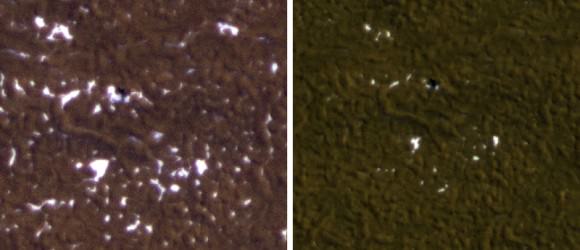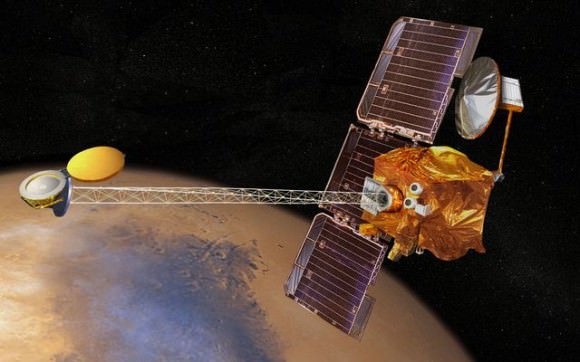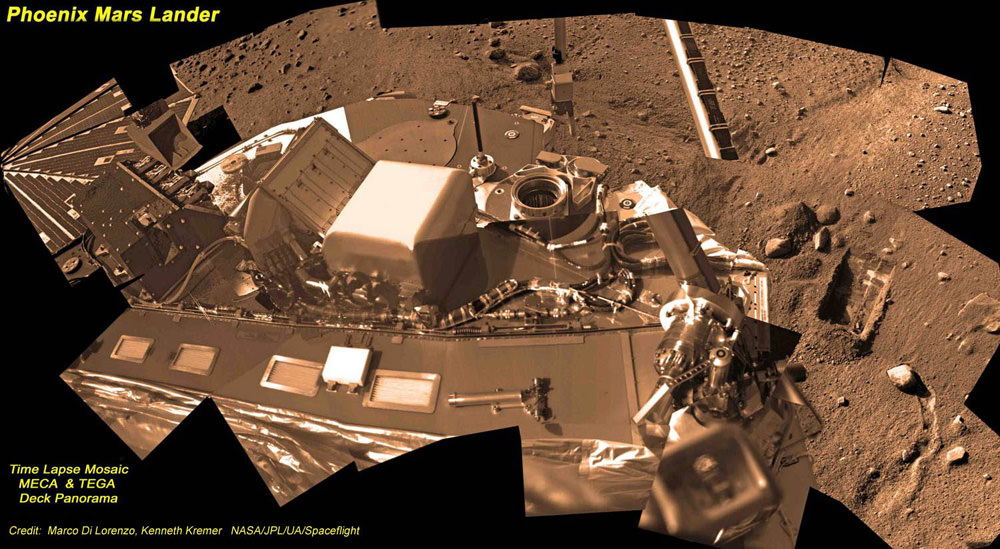[/caption]
As expected, NASA’s February 2010 listening campaign for the Phoenix Mars Lander has failed to detect any signals emanating from the long silent vehicle. NASA’s attempts to reestablish contact with Phoenix were restarted in January 2010 and timed to coincide with the onset of springtime and disappearance of ice at her location in the martian north polar regions. In theory, the return of abundant sunshine striking the twin energy producing solar arrays could again power up the science lander sufficiently to revive itself and ‘phone home’ to Earth.
This just completed 2nd listening campaign consisted of 60 overflights conducted by NASA’s Mars Odyssey orbiter from Feb 22 to Feb 26. The first campaign was conducted in January and likewise yielded no signals of activity. But with each passing Sol, or martian day, the sun is now rising higher in the sky and impinging longer on the solar powered craft. A third campaign is scheduled for early April 2010 just in case the sun enables a miraculous revival. The sun will be continuously above the Martian horizon in April.
Check out the time lapse photo mosaic above, created by Marco Di Lorenzo and Ken Kremer, which shows Phoenix actively at work as she digs up Martian icy soil samples and delivers them to the MECA and TEGA science instruments on the lander deck for compositional analysis.
It’s currently mid-springtime at the landing site with about 22 hours of sunlight each Sol. That illumination is comparable to the period when Phoenix was in full swing in the middle of her mission.
“Each overflight lasts about 10 minutes”, says Doug McCuistion, the director of Mars Exploration at NASA Headquarters in Washington, DC. But no one at NASA or on the science and engineering teams is under any illusions. “We think the chances are very low that Phoenix survived winter”, McCuistion told me in an interview.
NASA is using both of its Martian orbiting assets currently circling above the red planet to ascertain the condition of Phoenix. “Odyssey is the prime communications spacecraft. The Mars Reconnaissance Orbiter (MRO) will try to image Phoenix about every 2 weeks”, McCuistion said to me. See the latest MRO images herein which show a receding ice layer.

Phoenix was pre-programmed with a Lazarus mode to reawaken itself in the unlikely event that it survived the exceedingly harsh northern Martian winter during which it endured extremely low temperatures for longer than 1 earth year already. Furthermore, the spacecraft was potentially even partially encased in up to several feet of ice during several months of continuous arctic darkness. Unlike the rovers Spirit and Opportunity, Phoenix was not designed to withstand Martian winter.
After more than 5 months of intensive and breakthrough science investigations, all contact with Phoenix was lost on 2 November 2008 as increasing storm clouds blocked the waning sun from reaching the life giving solar arrays and the vehicle could no longer function.
Phoenix lasted more than 2 months beyond her planned primary mission design of 3 months. She discovered that Mars currently possesses a habitable environment with water and nutrients that could sustain potential past or current martian life forms, IF they exist. Read my earlier Phoenix report to learn about the robust science program that could be carried out to build on the initial results, if this bird rises again.
Earlier Mars article by Ken Kremer:
If Phoenix Arises, Science could flow quickly
Mars 2016 Methane Orbiter: Searching for Signs of Life
Phoenix mosaics by Ken Kremer and Marco Di Lorenzo at Astronomy Picture of the Day (APOD)
Phoenix and the Holy Cow APOD 12 Nov 2008
Phoenix and the Snow Queen APOD 12 Jun 2008
Phoenix mosaics by Ken Kremer and Marco Di Lorenzo at Spaceflightnow.com



Remember the strange growing ‘mold like’ salt/ice (?) deposits on the Phoenix landing legs? Got Windex?
Come on Phoenix, warm up and phone home!
Assuming the batteries aren’t just chunks of ice, its solar panels aren’t coated in a thick layer of caked on dust, and its innards aren’t cracked and corroded in multiple areas, the chances of this thing warming up and starting to beep are still extremely slim.
This is the kind of extreme cold soak that can break solder joints and weaken any electrical contacts not specifically designed for the situation.
I wouldn’t hold my breath waiting…